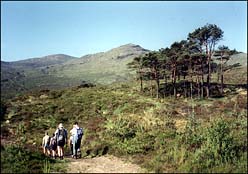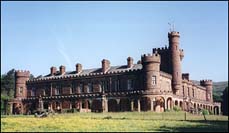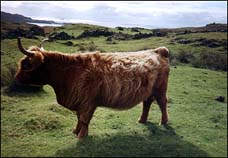Helen Rose's Hill Diary - April, 2002
Island of Rum

The island of Rum lies to the south west of Skye off the west coast of Scotland. It is a nature reserve with no indigenous population and is owned by Scottish Natural Heritage, a Scottish Parliament Quango. The island is mainly populated by staff of the SNH and the number of residential visitors is limited - with prior permissson required from SNH. There are day trippers to the island by both the Calmac ferry from Mallaig and smaller boats from Arisaig and other ports on the mainland. The island is north of the Island of Eigg which is famous for having been bought out from the landlord by a Community Trust.
The aims of Scottish Natural Heritage are to secure conservation and enhancement of Scotland's unique and precious natural heritage. They are aiming to restore the island to its former natural state prior to the clearances (both people and vegetation) for sheep farming in the 19th century. Deciduous trees indigenous to Scotland are being planted and highland cattle and deer are being bred. Strangely enough there is a herd of wild goats on the island with horns similar to ibex - they are reputed to have come to the island from a ship sunk in the Spanish Armada. We came across them on the west of the island at a beach near Harris. Gradually the population of the island is increasing and there are plans for community and housing developments.

I spent a long weekend on Rum with my hill walking pals in atrocious weather but it was fun none the less. It rained a lot but fortunately we have photographs from a previous visit by some of the group in glorious weather. Most of us stayed in Foxglove Bothy located in a lovely woody setting outside the main hamlet of Kinloch. The Kinloch Castle was built in the late nineteenth century by a wealthy, Northern English industrialist who was a friend of the Royal Family. There are conducted tours of the castle by the SNH staff who give a fascinating insight into the lives of the wealthy at that time. There was an aviary full of flying exotic birds and lavish parties were held in the grand hall - away from the eyes of the servants so there is much speculation as to the goings on at these events.
The island had been purchased by the industrialist for hunting and the castle inhabited by the owners for only a few weeks per year. Other than the castle, the only buildings on the island are crofts. Accommodation at the castle is hostel style, however, some rooms have four poster beds. It is all very faded grandeur but warm and comfortable and the warden's wife is an excellent cook!
Most of the hills on the island have Nordic sounding names such as Askival, Barkeval. Trallval and Hallival although there are also some Gaelic names. It suggests that the Vikings had control over Rum at one time! The correct name of the island is Rum but Queen Victoria changed it to Rhum to remove any suggestion it was linked to alcohol and therefore made it 'respectable'.

Togged out in waterproofs from head to toe, we set out for a walk but decided not to ascend a hill as it was very wet and misty.. We followed the Nature Trail from Kinloch on the east of the island aiming to walk to Harris on the west, around Barkeval, which is 571 metres high. On the way, we passed the herd of Highland Cattle. These were all cows and toffee coloured. The indigenous herd would have been black and there had been attempts to cross breed using a black Highland bull. Unfortunately, this had been unsuccessful as the bull was afraid of the ladies who had all ganged up on him!. At Harris, there was a mausoleum where the lady of the castle was buried. Looking like a small Roman Temple, it was strangely out of place near the beach in this remote Highland setting looking out to the Atlantic Ocean.
On the following day we explored the area on the peninsula in the north east at Mullach Mor but the walking was hard as there was thick undergrowth with no sheep to keep it under control and few paths on the island. In good weather there are excellent views of Rum from the Scottish mainland in Knoydart.
Fortunately, the weather cleared on our second last day and we climbed Hellival in sunny and windy conditions and could see the Cuillins of Skye. The next day we walked south on the Dibidil Path and if the weather had been clear we would have climbed the steep Sgurr nan Gillean.
The long weekend turned into an even longer one as the boat was cancelled due to storms when we had expected to leave the island. We stayed an extra day and finally chartered a private boat from Arisaig to leave the island. The staff in the Arisaig Hotel must be praised for being sympathetic to a group of very wet walkers who hung their dripping attire around the hotel while having coffee.
We may have been unlucky with the weather but it is a good excuse to return to Rum and climb those mountains which eluded us. Must get back before the tourists find out about it!
Scottish Natural Heritage Web site: http://www.snh.org.uk
Coming attractions: Weekend in Braemar and a walk in Brazil.
E mail me at helenrose52@hotmail.com
Thanks to Tom Addie and Frances Rickus for the photos.






